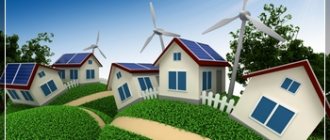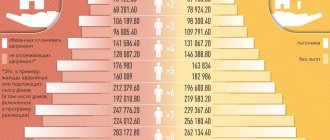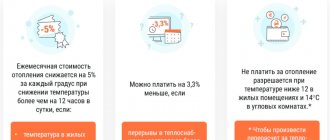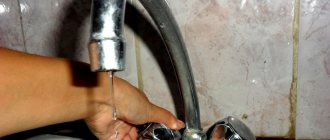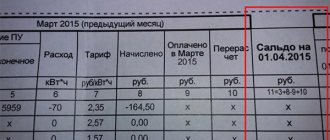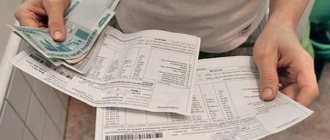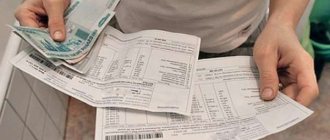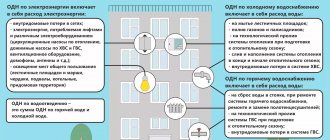Author's rating
Author of the article
Yulia Kuprina
Certified lawyer. Total work experience in the specialty is 13 years.
Articles written
23
about the author
A long-term reform in the public utilities sector obligated all residents to install utility meters. For those who do not have meters or are faulty, increasing coefficients have been introduced. We will talk about the use of an increasing coefficient in the absence of metering devices, when and why it is used, and also about whether it is profitable to live without water meters.
Increasing coefficient for utilities: regulations and laws
The amount of payments for utilities according to the standard does not cover the total costs of their supply. Because the standard is calculated based on the number of people registered in this living space. Whereas in reality a much larger number of people can live there. It turns out that part of the resources spent remains unpaid. And the municipal authorities do not have the money to cover them.
Individual metering devices record actual resource consumption. And payment is made based on meter readings.
This situation is beneficial to the authorities. And also to citizens who consume much less resources required by the standards.
Therefore, Federal Law No. 261 of November 23, 2009 “On energy saving and energy efficiency and on amendments to certain legislative acts of the Russian Federation” ordered residential property owners to install utility meters. And this had to be done before July 1, 2013.
In order to eliminate the overconsumption of resources by those who did not install meters, increasing coefficients for utility services were introduced. This innovation was recorded by Government Decree No. 354 of May 6, 2011. ⇐
Thus, the multiplying factor is the indicator by which the tariff for a certain utility service must be multiplied.
It must be said that today approximately 75% of apartments and private houses have meters for gas, water, heat and electricity. But still not everything. And they pay for services taking into account this coefficient.
How can I avoid being charged with a multiplier?
To do this , you need to prove that the lack of resource consumption meters is not a whim of the owner, but a lack of technical necessity.
This fact must be confirmed by an inspection report of the residential premises by authorized bodies.
The act is drawn up in the presence of the apartment owner, a representative of the resource supply company and a representative of the management company or HOA.
The document drawn up and signed will be the basis for not applying the increasing indicator for water supply.
For the lack of technical capabilities, one of the following conditions is accepted:
- it is impossible to install an IPU on water without carrying out reconstruction and major repairs of an apartment building, engineering and communication systems;
- it is not possible to comply with the standards and requirements when installing meters;
- there is no way to ensure proper operation of metering devices.
The identified reason for the lack of technical capability must be stated in the act. One copy of the document must remain in the hands of the owner of the premises, one in the management company or HOA, and one in the resource supply company.
Application procedure
The increasing factor applies to residential and non-residential premises in which:
- metering devices have not been installed, although the technical capability is available;
- the service life of the meters has expired;
- metering devices have not been timely verified;
- there is no opportunity to verify the accuracy of the testimony by representatives of the management company.
If residents have not provided meter readings, then they are also charged according to the standard using multipliers. But as soon as the readings are transmitted, a recalculation will be made.
Please note that at the end of the service life of metering devices, 3 months are given to replace them. The accrual at this time will be calculated based on the average readings for the last six months. Therefore, it is better to check and replace meters in advance.
The coefficient does not increase if:
- there is no technical possibility to install meters in the house (apartment);
- your home is considered unsafe;
- hot water flows only into the heating system;
- The house has low heating and electricity consumption.
The fact that it is not technically possible to install meters is not judged from the words of the homeowner. A special examination must be carried out. And its results are sent to companies providing housing and communal services.
If, despite these exceptions, the payment was still calculated taking into account the multiplier, then you need to contact the management company for an explanation.
When is it used?
Multipliers can be used only if the lack of water supply meters is the initiative of the apartment owner and there is a technical possibility for installation.
The lack of technical capability must be confirmed by the relevant act, then the indicator will not be used in the calculation.
The multiplier cannot be used in the following cases:
- in a communal apartment, where it is not possible to take into account the individual resource consumption of each resident;
- The room is equipped with a drainage system.
The coefficient can only be applied to homeowners. If the apartment is in social rent, then the tenant must contact the local authorities with a request to establish an IPU. They do not have the right to refuse if there is a technical possibility.
In a private, garden or country house, metering devices can be installed if the building is recognized as residential. In the absence of IPU, a multiplying factor can be applied to the cold water supply.
Increasing coefficient for utilities in Moscow, St. Petersburg and other cities
The amount of rent in the absence of metering devices depends on the established tariffs, multiplied by PC. If the coefficient is the same for all subjects, then the tariffs in each region are different. Moreover, they also increase regularly.
The highest prices are traditionally in Moscow. Muscovites pay for electricity from 5 rubles. 66 kopecks per kW/h. For cold water 42 rubles. 30 kopecks per cubic meter (according to meters, not counting drainage), for hot food - 205.15 rubles. By the way, if more than 10% of the budget is spent on rent each month, then residents of the capital have the right to a subsidy.
In St. Petersburg in 2021, residents of St. Petersburg pay 33.12 rubles for cold water, 112.82 for hot water. Electricity in houses with gas stoves costs 4.89 rubles. per kWh.
And in other cities of Russia the situation is not rosy. According to the Institute of Natural Monopolies, out of 15 million-plus cities, 10 exceed the limit for housing and communal services. At the top of the list is Omsk. Here, in the second half of 2021, tariffs increased by 9%. Among other cities, the list included Rostov-on-Don, Voronezh, and Yekaterinburg.
The excess was not recorded in 5 cities: Moscow, St. Petersburg, Nizhny Novgorod, Perm and Ufa.
These data indicate that the Government Resolution on reducing abuses and exceeding the maximum growth rates for housing and communal services was adopted at the right time.
Application of a multiplying factor in the absence of metering devices
In 2021, the coefficients are applied regardless of the form of ownership of residential and non-residential premises - to the owners, to those living under a social tenancy agreement.
If payment for utilities is not made for more than 2 months, then a debt has already formed and fines will be charged.
The state recommends using the funds received from the increasing coefficient to update equipment and technical systems.
The owner must install the meters at his own expense. And the management company is responsible for the installation of communal metering devices.
But if metering devices are still not installed, then no legal measures can be taken.
What is included in the rent? Usually this:
- heating;
- water supply;
- drainage;
- gas;
- electricity;
- garbage removal.
Their rates increase annually, usually in January and July. The rate of their growth is frightening. Therefore, the government has tightened control over exceeding the maximum cost of utility services at the regional level.
Meanwhile, the size of the increasing coefficient is set the same for all subjects. His promotion is not expected.
For heating in the absence of a meter 2021
The lowest coefficient is for heating. It is equal to 1.1. That is, for heat in apartments, consumers who do not have communal or appropriate individual meters pay 10% more. For other services it is much higher.
For water without a meter
If the apartment does not have a water meter, then payment is made according to the norms. The standard is calculated based on the average water consumption per day. According to Sanpin, one person consumes 140 liters of water per day. This includes cleaning, cooking, washing, and so on.
A tariff is set for this consumption rate.
Consumption standards and tariffs in each region may be different. Read more in the article: standard for cold and hot water consumption without a meter. ⇐
The increasing coefficient for water is set at 1.5. That is, if there are no metering devices, then payment is made according to the standards and at one and a half times the amount.
Cold water
The monthly consumption of cold water is approximately 6.9 cubic meters. Of course, not everyone really uses that much.
Therefore, paying for the volume averaged by legal standards, and even 50% more expensive, is extremely unprofitable for most people.
Hot water
There are 2 types of tariffs for hot water supply.
- Calculation in cubes. In this case, the calculations for DHW and cold water are similar. Only the standard for hot water is 4.7 per person.
- Two-component tariff - thermal energy + cold water. That is, water consumption standards are taken and multiplied by the amount of heat that was required to warm it up. And then – to the increasing component (1.5).
For electricity
Electric meters are traditionally available in most premises. But there are situations when the meter failed, was not replaced on time, or employees of the service provider organization were not allowed to check the readings. Then the increasing factor is 1.5.
It’s a different matter if it was discovered that electricity was being consumed bypassing the meter or if irregularities were recorded in the operation of the device itself (for example, seals were broken). This approach is, of course, illegal and is a serious violation. And the PC size can reach 10.
Important Features
There are examples in which even electricity meters are beneficial for citizens. When children and grandchildren are registered in the parental apartment, but in fact only the parents themselves live, and relatives rent housing. In the summer, spouses can completely go to the dacha, visiting the apartment only on weekends or even less often. Despite this, a receipt will be sent monthly with increased rates for six, despite the fact that two people use the resource and not throughout the year. Of course, here the counter is more than relevant and necessary.
When calculating the benefits, it is necessary to take into account the number of metering devices that need to be installed. You will have to buy them with your own personal funds and pay the craftsmen out of your own pocket for the work. The cost of equipment and services varies in each region. In addition, before purchasing, you need to clarify which models are used in a given region and specific house, since not all are suitable. Internal meters are cheaper than street meters. This is also important to take into account, especially for owners of private houses.
After the expiration date of the metering device, it must be reported and replaced within one month. Replacement is paid, but sometimes management companies do this work for free, depending on what is stated in the contract.
How to calculate the multiplying factor for: water, electricity, heating
To calculate the cost of water supply services taking into account the coefficient, you need to multiply the number of people living in the apartment by the consumption standard. Then it is multiplied by the increasing factor (1.5) and the tariff established in the region.
Electricity fees are calculated in the same way, the coefficient is 1.5.
And when calculating the cost of heating, the number of residents is replaced by the total area of the premises, both for residential and industrial enterprises and organizations. PC here is 1.1.
How to avoid paying a multiplying factor
The basis for introducing a multiplier is a number of regulations. Therefore, it is legally possible not to pay for it if this is not possible for technical reasons.
Or (the best option) install individual metering devices in the apartment.
In what cases is the absence of a counter beneficial?
The majority of the population does not want to overpay money in vain. Therefore, they purchased and installed meters. In 2-3 years, their expenses are fully justified. Who belongs to them:
- there are more people registered in the apartment than live;
- often leave for a long time;
- no one is registered in the apartment, and the owner lives elsewhere;
- use resources sparingly.
However, there are people who benefit from paying according to the standards. This:
- there are many more people living in the premises than registered;
- among the residents there is a beneficiary for housing and communal services;
- the apartment is for rent.
Also, residents of communal apartments and dormitories often do not install individual meters. Or communal meters are installed there. And the required amount is distributed among all residents.
Why do they increase the coefficient?
According to statistics, 70% of the population in Russia have meters installed. Others are in no hurry to install for completely different reasons. This may be a lack of financial resources for low-income families, since you need to buy an meter yourself and pay for its installation and registration. Or the previously mentioned benefit from the absence of meters when there is a difference in the number of registered and occupied persons in the premises. When the owner has a private home, he can take time to install equipment for metering the resource consumed because he uses heating, electricity and water not only for his home, but also for a greenhouse or garage. Accordingly, when taking into account the meter indicators in this situation, the size of payments will increase significantly, and this is not beneficial to the owner.
The use of increased tariffs is one of the measures in the implementation of federal legislation. It is in the interests of the government to stop the theft of communal resources, which is the cunning of some
citizens who deliberately refuse to install meters, knowing that they spend more than they pay.
However, although the law obliges the installation of metering devices if technically possible, there are no other sanctions for failure to comply with this requirement other than the application of increasing coefficients.

